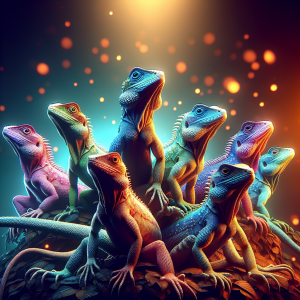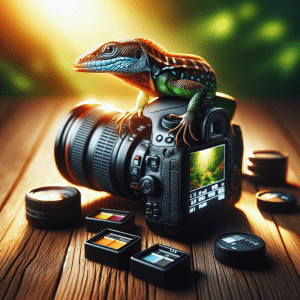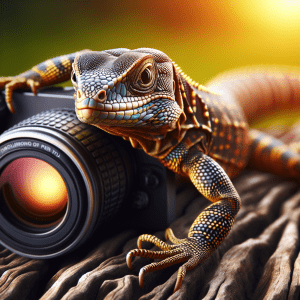Understanding Lizard Body Language in Photography
Have you ever tried to decipher the fascinating world of lizard body language through photography? Let me tell you, it’s a journey like no other.
Capturing the subtle gestures and expressions of lizards in your photographs can truly unlock their hidden secrets. It’s like being a detective in the wild!
When I first started exploring lizard body language in photography, I was amazed by the wealth of information these creatures communicate non-verbally. It’s a whole new language waiting to be understood.
Did you know that lizards use body language to communicate their mood, intentions, and even establish dominance within their territory? It’s a complex form of expression that goes beyond words.
As you delve into the world of lizard body language photography, remember to observe their behavior closely. Look for cues like head bobbing, tail flicking, and body postures that reveal their emotions and interactions with the environment.
The challenge lies in capturing these fleeting moments of lizard communication in a single frame. But with practice and patience, you can master the art of showcasing their unique body language through your lens.
So, are you ready to embark on this visual journey into the captivating realm of lizard body language photography? Grab your camera, step into the wild, and let’s decode the secrets that these fascinating creatures hold.
Importance of Capturing Lizard Behavior
Have you ever stopped to consider the intricate beauty of lizard body language in photography? It’s truly remarkable. Capturing the subtle gestures and expressions of these creatures can offer a window into their fascinating world. Imagine freezing a moment in time when a lizard cocks its head in curiosity or puffs up its throat in a display of dominance. These images can tell stories and evoke emotions in ways that words simply cannot.
One practical tip for photographing lizard body language is to observe their behavior closely before snapping your shot. Understanding their movements and postures can help you anticipate the perfect moment to capture. Remember, patience is key when photographing wildlife – sometimes you have to wait for the magic to happen. By immersing yourself in the world of lizards and honing your photography skills, you’ll be able to create stunning images that showcase the beauty of their body language.
So, the next time you encounter a lizard basking in the sun or scurrying across a rock, take a moment to appreciate the artistry of their gestures. Who knows? You might just capture a photograph that leaves a lasting impression on both you and your audience.
Tips for Photographing Lizard Body Language
Understanding lizard body language in photography is like deciphering a secret code in the wild. Each flick of their tongue, every twitch of their tail, tells a story waiting to be captured through your lens. It’s a dance of light and shadows, revealing the hidden world of these remarkable creatures.
When you immerse yourself in the art of photographing lizard body language, you enter a realm where patience and observation are your greatest allies. It’s not just about snapping a picture; it’s about capturing a moment frozen in time, a glimpse into their mysterious world.
Imagine the thrill of capturing a lizard’s subtle head bob or its graceful pose as it basks in the sun. These moments are fleeting, but with the right techniques, you can immortalize them forever. It’s a blend of artistry and science, where your camera becomes a tool for storytelling.
To truly master lizard body language photography, you must learn to anticipate their movements, to see beyond the surface and capture the essence of their behavior. It’s a journey of discovery, where each click of the shutter brings you closer to understanding these fascinating creatures on a deeper level.
So, grab your camera, venture into the wild, and let the world of lizard body language photography unfold before your eyes. Are you ready to embark on this mesmerizing journey?
Choosing the Right Camera Equipment
Choosing the right camera equipment is crucial for capturing stunning lizard body language photography. The type of camera you use can greatly impact the quality of your images. Investing in a camera with a high-resolution sensor and good low-light performance will help you capture the intricate details of lizard behavior.
When I first started photographing lizards, I made the mistake of using a basic point-and-shoot camera. The results were lackluster, and I knew I needed to upgrade my gear to truly capture the essence of these fascinating creatures.
A practical tip to enhance your lizard photography is to use a macro lens. This specialized lens allows you to get up close and personal with your subjects, capturing every intricate detail with clarity and precision. By using a macro lens, you can showcase the subtle nuances of lizard body language that may go unnoticed with a standard lens.
By choosing the right camera equipment and accessories, you can elevate your lizard body language photography to a whole new level. Remember, the camera is your tool for storytelling, so invest in quality gear that allows you to capture the magic of these incredible creatures.
Lighting Techniques for Lizard Photography
When it comes to capturing lizard body language through photography, it’s all about patience and observation. Lizards are fascinating creatures, each with its unique gestures and expressions. As an expert in lizard photography, I’ve spent countless hours in the field, studying these reptiles’ behavior up close. One key tip I can offer is to blend in with your surroundings and move slowly to avoid startling them. It’s amazing how much you can learn about a lizard’s mood and intentions just by watching its body language. Have you ever noticed how a lizard puffs up its throat when feeling threatened or how it basks in the sun to regulate its body temperature? These are the moments you want to capture in your photographs – those raw, authentic displays of lizard behavior that tell a story. Remember, patience is your best friend when photographing lizards. Take the time to observe their movements, anticipate their actions, and be ready to press that shutter button at the perfect moment. By immersing yourself in the world of lizard body language, you’ll not only improve your photography skills but also gain a deeper appreciation for these incredible creatures. So, next time you’re out in nature with your camera, keep an eye out for those subtle cues and gestures that reveal the hidden language of lizards.
Composition and Framing Techniques
Alright, let’s dive into the fascinating world of lizard body language photography! When it comes to capturing these intriguing creatures on camera, composition and framing techniques play a crucial role.
First off, imagine you’re in the wild, camera in hand, and suddenly, a lizard appears, showcasing its unique body language. You want to capture that moment perfectly, right? That’s where composition comes into play.
By framing your shot thoughtfully, you can emphasize the lizard’s body language – whether it’s a territorial display, a defensive posture, or a curious tilt of the head. Consider the rule of thirds to create visually appealing images that draw the viewer in.
Experiment with different angles and perspectives to highlight the most expressive gestures of the lizard. Get down low to capture a lizard’s eye view or zoom in to focus on intricate details like scales or eye movements.
Remember, photography is all about telling a story. What story does the lizard’s body language tell you? How can you convey that message through your lens?
So, the next time you’re out photographing lizards, think beyond just snapping pictures. Take the time to compose your shots thoughtfully, framing the lizard’s body language in a way that captivates your audience and tells a compelling story.
Editing Tips for Enhancing Lizard Images
When it comes to editing your lizard body language photographs, it’s all about enhancing their story. Are you ready to take your lizard images from good to jaw-dropping? Let’s dive into some editing tips that will make your lizard subjects pop on screen or in print.
The key to editing lizard photos is to enhance the natural beauty of these captivating creatures without overdoing it. Remember, less is often more in the world of photo editing. Start by adjusting the brightness and contrast to highlight the intricate details of your lizard’s scales and expressions.
Next, consider playing around with the saturation and color balance to bring out the vibrant hues of your lizard’s environment. By fine-tuning these settings, you can create images that truly capture the essence of lizard body language in all its glory.
Don’t forget about cropping and framing your photos to draw the viewer’s eye to the most compelling aspects of your lizard’s body language. Experiment with different compositions to find the perfect balance between subject and background.
Lastly, embrace the power of post-processing tools to add creative effects or filters that enhance the mood of your lizard images. Whether you’re going for a dreamy soft focus or a bold high-contrast look, editing tools can help you elevate your lizard body language photography to the next level.
So, are you ready to unleash your editing skills and bring your lizard body language photographs to life? Get creative, experiment, and most importantly, have fun capturing the fascinating world of lizards through your lens.
Common Mistakes to Avoid in Lizard Photography
Alright, let’s dive into a crucial aspect of lizard photography: editing tips for enhancing your lizard images. Editing is like sprinkling a touch of magic dust on your photos, transforming them from good to outstanding. Picture this: you’ve captured a stunning shot of a lizard basking in the sun, but the lighting isn’t quite right. Here’s where editing comes in handy. With a few tweaks here and there, you can adjust the brightness, contrast, and colors to make your lizard truly pop on screen. It’s like giving your lizard model a glamorous makeover!
Now, imagine this scenario: You’ve taken a fantastic photo of a lizard mid-leap, showcasing its agility and grace. However, there’s a distracting background that takes away from the lizard’s beauty. This is where editing software can work wonders. By using tools like cropping or blurring, you can focus all the attention on your lizard subject, creating a captivating image that tells a story. It’s like painting a masterpiece with pixels!
Remember, editing should enhance your lizard photos, not overshadow them. Think of it as polishing a gem to reveal its true brilliance. So, the next time you’re editing your lizard images, experiment with different tools and techniques to bring out the best in your photos. With a bit of practice and creativity, you’ll be amazed at how editing can elevate your lizard body language photography to a whole new level.
Showcasing Your Lizard Body Language Photography
When it comes to showcasing your lizard body language photography, the key lies in presentation. You want your images to not just capture the moment but to tell a story. Think about the story you want to convey through your photographs. Are you highlighting the intricate communication between lizards? Or perhaps showcasing the beauty of their natural habitats? Whatever it may be, make sure your images speak volumes.
Consider the framing and composition of your photographs. Play with angles and perspectives to create visual interest. Experiment with different lighting techniques to enhance the mood and atmosphere of your shots. Editing can also play a crucial role in bringing out the best in your lizard body language images. Remember, less is often more when it comes to post-processing.
One practical tip is to always be patient and observant when photographing lizards. Sometimes, the most captivating moments happen when you least expect them. So, keep your camera ready and be prepared to seize the opportunity when it presents itself. By honing your skills and developing your unique style, you can truly elevate your lizard body language photography to the next level.
Resources for Further Learning
Ever wondered how to capture the subtle nuances of lizard body language in your photography? It’s a fascinating world out there, filled with intricate gestures and behaviors that convey so much without uttering a single word. As an expert in this field, I’ve spent countless hours observing these incredible creatures and honing my skills behind the lens.
One practical tip I can offer is to take the time to really study your subjects. Watch how they move, how they interact with their environment, and how they communicate with each other. This deep understanding will not only help you anticipate their next move but also enable you to capture those decisive moments that truly tell a story.
Photographing lizard body language is not just about snapping pretty pictures; it’s about capturing the essence of these fascinating creatures and sharing their world with others. It’s a way to bridge the gap between humans and reptiles, allowing us to appreciate and respect the beauty of nature in all its forms.
So, the next time you’re out in the wild with your camera in hand, take a moment to observe the subtle cues and expressions of the lizards around you. Who knows what hidden messages they might be trying to convey through their body language? Dive into this captivating world of lizard photography, and you’ll discover a whole new dimension of storytelling waiting to be told.




